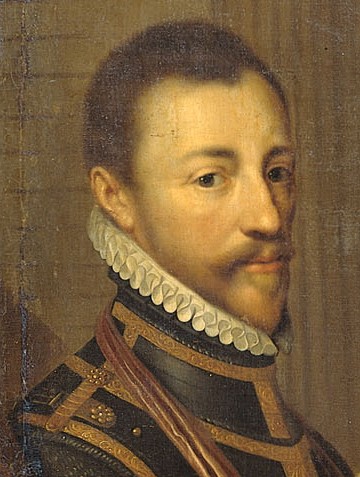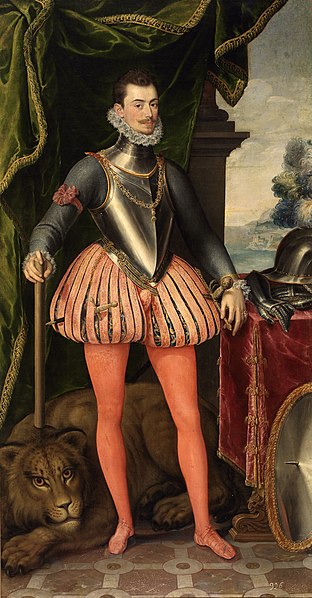 |
| Charlotte de Bourbon-Montpensier |
In March 1572, although the divorce had not been publicised, the first news appeared of William’s impending remarriage. His chosen wife was the former Abbess of Jouarre[i], Charlotte de Bourbon-Montpensier, a daughter of Louis II of Bourbon, Duke of Montpensier, and his first wife, Jacqueline de Longwy. Anna of Saxony’s Hessian and Saxon relatives were infuriated by the rumours and on 1st October 1572 they arranged for her transfer to Beilstein castle with Christine[ii].
It was not only Anna’s relations who were annoyed by the impending remarriage; William’s brother John refused to release the divorce papers and William had the evidence re-examined by a theological commission in Holland. In April 1573 William returned to the faith of his childhood. William married the penniless Charlotte on 24th June 1575[iii]; he was in love. He wrote to John;
‘[I am tired] of this state
of widowhood in which to my great regret, I have had to remain for so long.’[iv]
Anna’s Uncle
August ordered the immediate transfer of his niece from Nassau to Saxony. In December 1575 Anna learned of her
forthcoming transfer to Saxony and she attempted suicide. After a long stay in Zeitz, she was taken to Dresden in December 1576. There, the windows of her
room was walled up and fitted with additional iron bars[v].
Spanish Desperation
 |
| The battle of Mookerheyde |
Philip William, far from home and family and a victim of
Philip’s fears, was moved from fortress to fortress in Spain. His friends and
trusted servants were taken away from the 19 year old; Philip William wrote to
his father secretly and sent his correspondence via a washerwoman whose son was
fighting in the Netherlands. William had his son’s letter by the spring; it was
not the only time letters from Philip William came this same route. William
could only hope that he would be able to rescue his son in an exchange of
prisoners at some point.
Philip believed that as Medinaceli and Alba’s methods were incompatible they would both have to be replaced. Medinaceli’s successor as Governor was Luis de Requesens y Zúñiga who arrived in Brussels on 17th November 1573. Alba returned to Spain in December, a defeated man. Requesens launched a new military campaign.
 |
| Louis of Nassau |
As a free people, the Dutch willingly accepted far higher
levels of taxation to fund their freedom than had ever been imposed by Alba.
The port of Middelburg fell to
the rebels on 18th February 1574, with the active assistance of the
Sea Beggars.
Requesens' army obtained a victory against Louis’ troops
at the Battle of Mookerheyde, during which two
of William's
brothers, Louis and the youngest of the Nassau-Dillenberg brood Henry, were killed. William wrote to John
‘Pray you to give me good counsel what am I to tell my lady my mother,
knowing not whether to condole her on the loss of my brothers, being still
ignorant whether they be dead or living; I would not distress her without
cause..’[vi]
But no trace of either brother’s body was found and
William waited in hope for either Louis or Henry to turn up. Louis had been
their mother’s favourite child and William’s grief rarely allowed him to talk
of his brother again.
Bankruptcy
 |
| Luis de Requesens y Zuniga |
Over the next two years the rebels made many gains until
William and his supporters ruled over much of the north of the provinces. Requesens
felt he had to come to an agreement with William and invoked Maximilian’s
mediation; the negotiations were held in Breda. Requesens declared himself
ready to remove his troops from Flanders, but in exchange Catholicism was to be
the only religion. He also lifted the much Tenth Penny tax and proposed to
pardon all who bowed down to Philip.
The proposals were rebuffed by the Dutch, unable to
accept the religious dictat. Requesens approached William privately offering a
private peace between himself and Philip; William informed Requesens that he
was no longer a private person and could not accept.
Requesens restarted the military campaign and his troops
occupied much of Zeeland. In 1575 the cost of maintaining a
standing army, of 60,000 men, in the Netherlands was too much for the Spanish
treasury and in September declared itself bankrupt, despite the monies pouring
in from the Americas.
One Spanish fleet had been wrecked on the Dutch coast
during 1572, the loss of which was a huge blow to the treasury. 400,000 florins[vii]
for payment of the troops was held in England when the ships carrying the
troops’ pay took shelter there from a storm.
When the flow of money to Flanders abruptly stopped the
troops mutinied.
Requesens wrote despairingly;
‘No treasury in the world
would be equal to the cost of this war.’[viii]
But his
master was obdurate; following mass desertions military operations were
halted for one year. Requesens died suddenly at Brussels on 5th
March 1576, to be replaced as Governor of the Netherlands by Don Juan of
Austria[ix]. Ten
days later William’s wife Charlotte bore their first child on 15th
March 1576, Louise
Juliana van Nassau.
A New Hand at the Tiller
 |
| Don Juan of Austria |
Don Juan arrived in the Netherlands in the autumn; he was
a man with a plan (albeit unrealistic); he would clear out the rats nest in
Antwerp, settle the revolt, invade England, set free and marry Mary Queen of
Scots and restore Catholicism to the British Isles. He was taken aback to
discover the sixteen provinces ranged against him, united by the Pacification of
Ghent, signed on 18th November 1576.
On 8th November 1576 the unpaid Spanish troops
had sacked Antwerp
with a savage brutality which became a byword for Spanish dealings with their
foreign subjects.
‘They neither spared age nor sex; time nor place; person nor country; young
nor old; rich nor poor…..and as great respect they had to the church and
churchyard as the butcher has to his shambles. They spared neither friend nor
foe, Portugal nor Turk; the Jesuits must give their ready coin and all other
religious house both corn and plate.’[x]
Don Juan was relatively perspicacious in his initial
actions; he sought to woo the nobles living in the southern provinces, and
separate them off from the more rebellious north. Nobles like the Duke of
Aerschot were ready to accept Don Juan’s promises. William stayed away from the
estates General, leaving the work there to Marnix and Paul Buys, the
Pensionary of Leiden.
 |
| Paulus Buys |
Marnix and Buys were easily able to play the fault lines
in the Estates, exacerbating the differences between the often arrogant
Aerschot and his friends and the burghers. Aerschot’s unveiled ambitions led to
the Second
Union of Brussels, consolidating the agreements of the Pacification
of Ghent. In December 1576 Queen Elizabeth offered the rebels a loan of £20,000[xi]
to pay for immediate necessities and further monies if Philip proved intractable.
Bibliography
The Age of
Religious Wars – Richard S Dunn, Weidenfeld & Nicholson 1971
The Revolt
of the Netherlands – Pieter Geyl, Cassell History 1988
Walsingham –
Alan Haynes, Sutton Publishing 2004
The Holy
Roman Empire – Friedrich Heer, Phoenix 1995
The Spanish
Inquisition – Henry Kamen, Phoenix 1998
Philip of
Spain – Henry Kamen, Yale University Press 1998
The Spanish
Armada – Colin Martin and Geoffrey Parker, Guild Publishing 1988
The Grand
Strategy of Philip II – Geoffrey Parker, Yale University Press 1998
Elizabeth –
Anne Somerset, Phoenix Giant 1999
William the
Silent – CV Wedgewood, Readers Union Ltd 1945
The
Hapsburgs – Andrew Wheatcroft, Folio Society 2004
[i]
Her father had placed her in the convent, ignoring her protests, possibly
because Charlotte and her mother espoused the reformed doctrines
[ii]
Christine was removed from her mother’s care three years later
[iii]
Outraged at this news, some of
Anna's relatives demanded the return of large wedding gifts despite her
infidelity. Her Uncle August also demanded of William, whom he now called ‘Head of all the rogues and rebels’, one
of the counties of Nassau, Hadamar and Diez. He also insisted that the marriage
was not legally ended yet, and thus William had no right to remarry.
[iv]
William the Silent - Wedgewood
[v]
At the door was a square hole in the
top panel that provided a narrow grid, which was closed off outside. Through
this hole food and drinks were served to her. In front of the door there was an
iron gate, virtually guaranteeing that Anna had no chance of escape In May 1577
Anna started having hemorrhages which continued until her death on 18th
December, shortly before her 33rd birthday
[vi]
William the Silent - Wedgewood
[vii]
In 2014
the relative: historic standard of living value of that income or wealth is £289,900,000.00 economic status value of that income or wealth is £10,490,000,000.00 economic power value of that income or wealth is £181,800,000,000.00 www.measuringworth.com
[viii]
The Spanish Armada – Martin & Parker
[x]
William the Silent - Wedgewood
[xi]
In 2014
the relative: historic standard of living value of that income or wealth is £5,519,000.00 economic status value of that income or wealth is £172,000,000.00 economic power value of that income or wealth is £1,775,000,000.00 www.measuringworth.com
No comments:
Post a Comment
Note: only a member of this blog may post a comment.